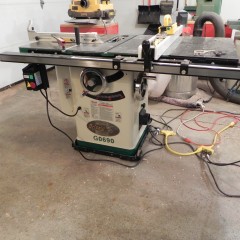The end of end tables
Last week before a trip to Dallas, I finished off the end tables. They are now proudly setting in my family room on either end of my sofa. The following photos are of the end tables just after being waxed.
Continue Reading…

The Normite section of my blog, some times I just want to play and talk about the big tools.
Last week before a trip to Dallas, I finished off the end tables. They are now proudly setting in my family room on either end of my sofa. The following photos are of the end tables just after being waxed.
Continue Reading…
As far as I’m concerned, the last big job is done. Panel glue ups used to be something that terrified me, because so much can go wrong. Over time I have come up with a system that works for me almost every time, even if the boards aren’t perfectly flat. The following series of images will show you how I make large panels.
Step one is to joint the edges of two adjacent boards. The best way to do this, is with a method communally used in the hand tool world. Jointing edges is something that is a lot harder to do by hand then by machine, thus people came up with book matched jointing. To do this lay the boards down as they would be glued up, and then fold them together as if you where closing a book. Roughly line up the edges, and then clamp the boards together. The benefit of this process, is that your jointer fence doesn’t have to be perfectly square to the bed.
Once the boards are all edge jointed it’s time to glue them up, and the best way to to do that is with a clamping jig, & cauls. The clamping jig is nothing more than two boards that have slots cut across them that hold your clamps up off the table in the vertical position. The only dimension of real importance is the height of the boards, you want them to be high enough so that you can clear the heads of the clamps that you are to clamp the cauls with. Continue Reading…
The drawer slides are done and mounted. I’m really happy with how they turned out, and how easily they slide with a little paraffin wax applied to the runners & kickers. As you can see in the second picture below, I still need to do a little adjustment work on the depth stops, but other than that they are good to go. I’ve already started working on the tops, in fact the glue ups are almost done. Check back soon, as I’m going to share the method I use to make nearly invisible glue joints.
It took a little longer than I thought it would, but the drawers are done. The only hang up was that the varnish had started to go bad while finishing the fronts, so I ended up sanding it all off and doing it over. The drawer front is finished with varnish just like rest of the piece. The sides back and bottom are finished with Zinsser’s Bullseye SealCoat(de-waxed shellac), as it helps seal the wood and provides a good vapor barrier. Next up are the kickers and runners.
With the main carcasses glued up and finished, it’s time to work on the drawers. The drawer sides aand back are Hard Maple and the front is obviously Jatoba. Sticking to my no plywood philosophy, The drawer bottoms are also made from Hard Maple, and are 1/4″ thick. These are light duty drawers, so the bottoms don’t need to be that thick.
The band-saw made short work of resewing 4/4 stock in half. I didn’t decide to cut saw thinner panels, because the boards moved a lot, and I just barely got them all to come in at 1/4 thick. I probably should have picked boards with straighter grain, but this is all my local supplier had. I decided to use half blind dovetails in the front, and a simple dado in the back. I originally planed on using through dovetails in the back, but ultimately decided it wasn’t worth the effort, since almost no one will ever see the joint. I hope to glue up the drawers and get some finish on them this week, so stay tuned.